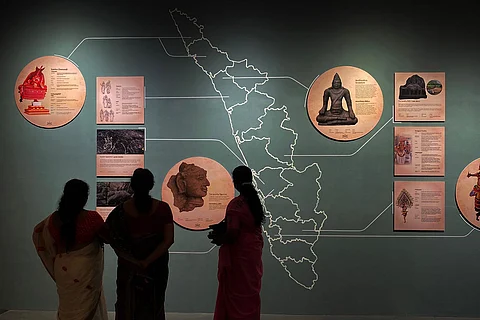

The Sree Sankaracharya University of Sanskrit in Kerala’s Kalady recently became the site of a first-of-its-kind museum that documents the history and evolution of the Malayalam language, as well as that of indigenous cultures in the state. The Kanakadhara Museum of Arts and Indigenous Culture was completed on August 26 and is currently open only to students and those connected to the university. However, once the COVID-19 situation improves in the state, the museum will be open to the general public as well, with safety protocols in place.
Twenty-eight-year-old Sathyajith Ibn is the chief architect behind this unique venture, which is the first designated university-run museum in the state. A native of Pathanapuram in Kollam district, Sathyajith is currently pursuing his PhD in preservation from the MS University, Baroda after obtaining an MA in Heritage Conservation and Museology from the National Museum Institute, New Delhi. He says that the Kanakadhara museum was realised after two and a half years of constant efforts. This involved extensive literary research, site studies and artefact collection, amalgamated with a cohesive structure and design concepts.
The unique feature of the museum, Sathyajith says, is the accurate timelines of the evolution of the language and culture of the state, which no other museum has. The display cases are also made of poly methyl methacrylate or acrylic glass, which is fire-proof and does not release polluting substances to the environment. Sathyajith adds that he researched on many materials before choosing ones which will not harm those visiting the museum.
“The museum was designed and made for the university, with regard to the institution's request to have an establishment that shoulders historical insights within students and the public. With a minimal collection of artefacts present with the university, the task at hand was to generate a collection and a storyline for the museum. Museums are normally established with an already existing collection, but this was not the scenario here and so the process was intensive and laborious”, Sathyajith tells TNM.
“The first gallery is attributed to the journey and evolution of Malayalam as a language and the milestones from the early period, when Vattezhuthu and Kolezhuthu were in use until the script was refined to the modern one we use today,” he adds. Some of the artefacts of the language gallery include palm leaf manuscripts from the 18th century written in Malayanma script, and the very first edition of the Bhashaposhini magazine, one of the oldest literary review magazines, from 1902.
An exhibit on the proponents of Malayalam literature
“The museum further incorporates elements of indigenous architecture, which showcases the various materials used by indigenous and tribal people of Kerala that laid the sustainable foundations of the state. The further galleries incorporate traditional and eclipsed art forms that have not been in the commercial forefront and a ‘heritage wall’, which elucidates the various oppressed cultures that need a platform to be recognised and sustainably revived,” Sathyajith says.
The hindmost gallery exhibits archaeological artefacts including hand axes which are more than 50,000 years old (from the Paleolithic period), along with iron tools and materials from the early historic periods, found in Kerala.
The final gallery portrays exhibits of the modern era, where students of the university will have a platform to exhibit their art work.
A design outlining the history of Malyalam at the museum
Sathyajith says that out of the two and a half years he spent in completing the museum, the first six months went into generating the establishment’s storyline and concept. Designing the galleries and executing the artworks and panels on the walls took two years.
“The written content in the museum was the result of months of archival studies and documentation, which enabled me to generate and design the panels that are exhibited in the galleries. The museum was built by local masons and workers. They never had experience in being part of a project that has elements of heritage, and one which requires extreme care and scientific approach. I spent the initial period interacting and training the workers on museum standards, and how materials need to be used within the galleries so that no harm occurs to the artefacts,” he explains.
An exhibit on the traditional architectural styles of Kerala
“Extreme care was taken in using materials to build the museum, where none of the materials used are perishable or vulnerable to fire or water damage and which create the most perfect micro climate for the artefacts. The requirements of the relative humidity and temperature and the chemical nature of the artefacts were studied, to use suitable materials for the exhibit cases and other interior elements,” he shares.
The recently-open Kanakadhara museum is expanding its collection, with more acquisitions of artefacts and design elements. It is an ode to the history, as well as the future, of the artistic, cultural and linguistic landscape of Kerala.
(All images from Sathyajith Ibn)